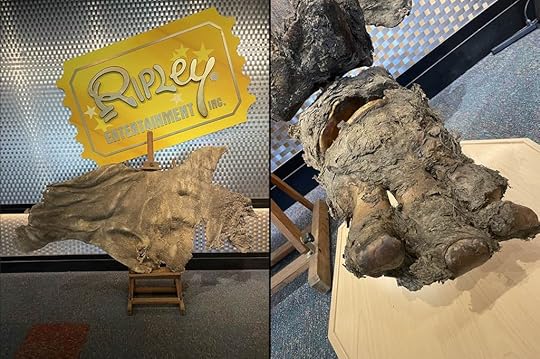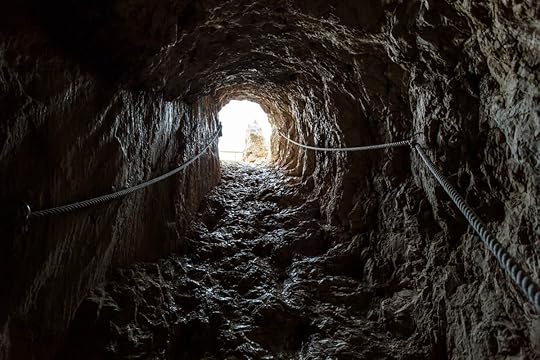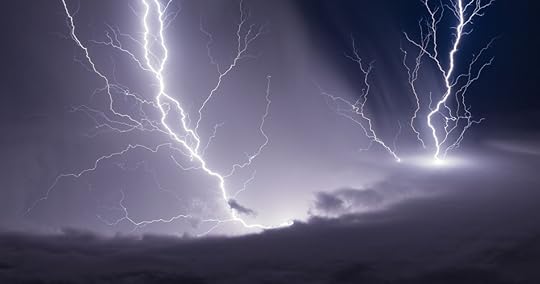Ripley Entertainment Inc.'s Blog, page 71
August 19, 2022
CARTOON 08-19-2022
August 18, 2022
How Ripley’s Came To Acquire A Mammoth Nipple
Featured in Ripley's Believe It or Not!

Over the past few years, many incredible discoveries have been made permitting us to reconstruct the daily lives of Ice Age mammoths. These include research into the stories written via chemicals in woolly mammoths’ tusks, per National Geographic. Matthew Wooller of the University of Alaska Fairbanks explains, “The tip of the tusk is the young mammoth. The base of the tusk is the old mammoth. Everything in between is the mammoth’s lifetime.”
But the fascinating insights into the lives of these incredible creatures of the past don’t end there. For example, the Waco Mammoth National Monument in Texas has provided researchers their first glimpses into a woolly mammoth nursery herd. By exploring the site, scientists have gained new information about these ancient pachyderms’ social structure and habits. Adding to our understanding of how these animals lived and raised young is a rare find of three preserved mammoth pieces, including a nipple, recently acquired by Ripley’s.
Here’s what you need to know about these pieces and other exciting research changing our views about life as a woolly mammoth.
The Daily Lives of MammothsWoolly mammoths flourished in Asia, North America, and Europe between 300,000 and 10,000 years ago. But the last group of these hairy pachyderms still existed in 1650 B.C. That’s more than a 1,000 years after the pyramids at Giza were constructed! This timeline coincided with much colder times on planet Earth.
Approximately 200,000 years ago, snow and ice sheets covered much of the planet, making for inhospitable temperatures that fur-covered creatures could appreciate. Paleontological evidence demonstrates these gentle giants stood roughly 13 feet tall, similar to the size of African elephants today.
Experiences in a Mammoth Nursery HerdWoolly mammoths foraged for food on the cold tundra of Asia, Europe, and North America, digging beneath layers of snow and ice with their tusks. These tusks could reach upwards of 15 feet long permitting them to find grasses and shrubs buried deep beneath the permafrost.

A heard of mammoths trucking through icy terrain.
Woolly mammoths gave birth and cared for one calf at a time like elephants do today. As social creatures, they banded together in groups of up to 15 individuals, with male juvenile mammoths remaining with the herd up to the age of ten. Large groupings of mammoths made it easier to keep terrifying Ice Age predators at bay, translating into significant longevity. Researchers have discovered females in these herds could easily live up to 75 years, whereas lone males rarely made it past their 40s, as reported by the National Park Service.
A Window into the PastLike other mammals, mammoths gave birth to live babies they nursed. Once a calf’s teeth developed, it began foraging like grown-ups. In the case of modern-day elephants, babies usually nurse for about six months before making the transition to solid foods.
The highly sought-after preserved mammoth remains acquired by Ripley’s — two large pieces of skin and a leg — originated in Siberia. Due to increased temperatures, glaciers have receded in recent years, revealing incredible finds like the preserved mammoth nipple. These samples were sent for testing at the Curt-Engelhorn-Center of Archaeometry. The Center used radiocarbon dating (14C) to determine the frozen fossils dated to roughly 49,000 years ago!

How does this testing work? Throughout an animal’s life, it assimilates carbon-14 from the atmosphere. But when it dies, this exchange comes to an abrupt halt, and then carbon-14 leaves the remains at a rate determined by radioactive decay. By measuring the amount of carbon-14 present in the samples and then comparing it to an international standard, researchers can estimate each piece’s age. We’ll keep you posted as more information surfaces about these one-of-a-kind discoveries and what they tell us about the Ice Age, its mammoths, and its ecosystems.
By Engrid Barnett, contributor for Ripleys.com
EXPLORE THE ODD IN PERSON! Discover hundreds of strange and unusual artifacts and get hands-on with unbelievable interactives when you visit a Ripley’s Odditorium!CARTOON 08-18-2022
August 17, 2022
That Time A Scientist Dug Secret Tunnels Under D.C. For Exercise
Featured in Ripley's Believe It or Not!

In 1924, a delivery truck fell victim to a crack in Earth’s foundation right behind Pelham Courts in Washington, D.C., submerging slightly into the ground beneath its tires. The Pelham Courts manager and janitor investigated and discovered the unlikely culprit: a maze of connected hidden tunnels.
They were built tall and wide enough for a human to effortlessly walk through them. An architect reported that the tunnels were constructed with precision and care. Lined with white enameled brick, explorers admired the beauty and value of these tunnels.
One interesting discovery was a collection of German newspapers lining the ceilings, lit by electric torches. This led to many speculating minds and people began to wonder how these tunnels came to be and who exactly was responsible for them.
Some thought they were deserted sewage tunnels, while others theorized it was a hiding space for German spies or bootleggers.
Digging for the FactsThe truth? Harrison Dyar, a former Smithsonian Institute entomologist, took full responsibility (well, after he had his fun hearing what people had to say about these mysterious tunnels).
His reason for the secret passageways? It was as simple as exercise. He looked at tunnel digging as not only a hobby, but a way to get his body up and moving after work. He admitted to working on these tunnels for upwards of 10 years, from 1906 to 1916.
In 1924, an elaborate tunnel was accidentally found under a street in Washington, D.C. Despite theories that it was a lair of bootleggers or ‘Teuton war spies’, the tunnel was dug by the Smithsonian entomologist Harrison G. Dyar, who just liked to dig tunnels in his spare time. pic.twitter.com/oaJKkoowL8
— Quite Interesting (@qikipedia) November 14, 2021
It started when he dug a flowerbed for his wife. He was compelled to keep digging, once telling a reporter “When I was down perhaps 6 or 7 feet, surrounded only by the damp brown walls of old Mother Earth, I was seized by an undeniable fancy to keep on going.” He had various locations where he did his digging — all around D.C. — and all with similar features such as electric lighting, stone stairways, and cement walls. Some were even up to 24 feet deep!
Tunnel VisionBelieve it or not, there may have been some truth to a few of the outlandish theories that took the community by storm before Dyar admitted to creating the tunnels. Dyar had no clue where the newspapers on the ceilings came from. There were also empty liquor bottles thrown on the ground and other signs of life throughout. Dyar had moved to California the year prior to the publication date of the newspapers (1917 and 1918) so he noted it couldn’t have been him who hung them up.

Explorers look at Dyar’s tunnel in Washington, D.C. in 1924.
With this information, it gave people even more of a right to believe that these tunnels were a place for German spies during WWI after the media publicized the tunnel discovery. Some even think Dyar was a spy himself!
The Human Urge to DigDyar wasn’t the first person to dig for pleasure, nor was he the last — far from it. Hobby tunneling is definitely still a thing, and most of this work is done by hand. Like Dyar, it can take decades to complete the tunnels, especially when digging without heavy equipment. You might be wondering why one would choose this as a hobby? Well, reasons typically include working out, getting one’s mind off other things, or creating something of purpose like a wine cellar.
But before you grab your shovel, it should be noted that tunneling isn’t without danger. Digging deep enough to put a layer of dirt above or even just around you comes with the inherent risk of the dirt or sand collapsing, possibly leading to injury or even being buried alive.
Can I Visit Dyar’s Tunnels?The Pelham Courts no longer exist, and neither do Dyar’s tunnels. They’ve been sealed off with concrete. That ground is now home to Hotel Palomar.
Many unanswered questions still linger to this day. How did Dyar get out of the tunnels when he was done digging for the day? How did he hide it so well? Did anyone else live down there? Guess that means it’s our turn to speculate – let us know your theories in the comments!
By Sam McCormack, contributor for Ripleys.com
EXPLORE THE ODD IN PERSON! Discover hundreds of strange and unusual artifacts and get hands-on with unbelievable interactives when you visit a Ripley’s Odditorium!Source: That Time A Scientist Dug Secret Tunnels Under D.C. For Exercise
CARTOON 08-17-2022
August 16, 2022
Upside-down Lightning In Oklahoma Most Powerful Ever Recorded
Featured in Ripley's Believe It or Not!

Located smack dab in the middle of Tornado Alley is Oklahoma, a state infamous for wild weather. The state has about 60 days of thunderstorms annually and roughly 53 twisters per year. It’s no wonder 1996’s Twister took place in the “Sooner State.”
Scientists recently discovered another powerful weather phenomenon attracted to Oklahoma: epic backward-flowing lightning bolts. Here’s what you need to know about these gigantic jets of static electricity and how scientists recently discovered the world’s most powerful one.
Lightning StrikesThe most enormous lightning bolt ever recorded did something unexpected: Instead of striking downward, etching a searing swathe of black destruction into the ground below, it streaked upward. Licking the very edge of space with its electric-sharp tongue, it shot 50 miles into the air, creating a hair-raising spectacle. Scientists refer to this kind of bolt as a “jet.” And this one was downright gigantic.
Upward streaming white-light jets prove incredibly rare. There are only about 1,000 instances worldwide each year. And unlike your average earthbound bolt, they are far more powerful. On average, they contain 50 times more energy. But that’s nothing compared to the Oklahoma jet.
The Most Powerful Lightning
On May 14, 2018, a tempest straight from The Twilight Zone rained over Oklahoma. https://t.co/BAesJuxBoH
— CNET (@CNET) August 11, 2022
The world’s most impressive lightning strike lit up the skies of Oklahoma in 2018. But it would take four years for scientists to offer up an analysis of its potency. They did this by analyzing its radio-wave emissions along with radar and satellite data. What they discovered is shocking (pun intended).
During the sky-piercing strike, 300 coulombs of energy were transferred from the origin point at the top of the cloud to the lower edges of space, an area known as the ionosphere. (The ionosphere is a layer of charged particles that delineates between the vacuum of space and Earth’s upper atmosphere.) Compared to your average lightning bolt with an output of 5 coulomb, that’s 60 times more powerful!
Recording the World’s Most Powerful StrikeApart from the incredible size and power of the strike, scientists were amazed at their luck in capturing this data in the first place. It all started when a Texas-based scientist recorded footage of the massive lightning bolt.
After reviewing the video, researchers realized the event happened near the center of a lightning mapping array (LMA). An LMA is a network of radio antennas that record lightning strikes’ times and locations. Besides collecting data from this LMA, the researchers identified several weather radar systems in close proximity. Coupled with recordings from weather-watching satellites, they had everything they needed for one of the most in-depth analyses of lightning ever undertaken.
What Goes UpNot only did they use this data to measure the size and power of the jet, but they also discovered that it was the result of smaller structures known as streamers which developed at the tip of the lightning bolt, forging a direct electrical connection to the ionosphere. Of course, this still leaves the broader question of why lightning sometimes flows up instead of down.
Scientists are still hashing this out. But Levi Boggs, a Georgia Tech Research Institute scientist, has a theory about this gravity-defying weather phenomenon. “For whatever reason, there is usually a suppression of cloud-to-ground discharges. In the absence of the lightning discharges we normally see, the gigantic jet may relieve the buildup of excess negative charge in the cloud.”
As scientists continue studying upside-down lightning bolts, they will likely look well beyond Oklahoma. As it turns out, most of these epic sky-crowning strikes occur in tropical regions, making the Midwest episode powerful and unusual.
By Engrid Barnett, contributor for Ripleys.com
EXPLORE THE ODD IN PERSON! Discover hundreds of strange and unusual artifacts and get hands-on with unbelievable interactives when you visit a Ripley’s Odditorium!Source: Upside-down Lightning In Oklahoma Most Powerful Ever Recorded
CARTOON 08-16-2022
August 15, 2022
CARTOON 08-15-2022
August 14, 2022
CARTOON 08-14-2022
August 13, 2022
CARTOON 08-13-2022
Ripley Entertainment Inc.'s Blog
- Ripley Entertainment Inc.'s profile
- 52 followers










